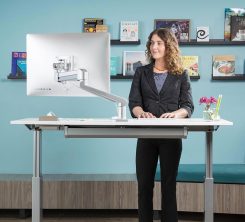
As experienced office interior designers, the role of IN2 SPACE Interior Design and Project Management is to not only design a workspace that looks good, but takes into account many elements that make it an exceptional place for all to work. Along with making a statement about your corporate identity, it needs to be functional from a OHS perspective; recognising the importance of components incorporated into design such as sit/stand desks in a workplace.
3 Top Benefits that Highlight the Importance of Sit/Stand Desks in a Workplace
A number of experts in the field of ergonomics have concluded that using Sit/Stand desks – alternating between both standing and sitting positions during work hours – provides a variety of health and workplace benefits. These include:
- employees reporting lower levels of physical discomfort
- improved mood states
- increased levels of productivity.
Sit/Stand desks are quickly gaining momentum in commercial and office interior design – particularly in Melbourne’s commercial, office fit-outs – as they begin to reflect the layout of modern-day offices all around the world.
Employee Health and Sitting at Work
Scientifically speaking, sedentary workplaces – where employees are required to sit for prolonged periods of time without moving – have never been beneficial to workplace morale or individual health. The hazardous effects associated with sedentary commercial and office interior designs are even more pronounced in employees who do not lead active lifestyles – whether it’s playing sport or regularly exercising at the gym. However, those who do lead active lifestyles are still at risk of developing serious health issues, due to being confined to a desk and chair in an office for extended periods. Once an office novelty, Sit/Stand desks are now becoming the norm, buoyed by rapidly accumulating research into the ill-effects of sedentary workstations or even fixed chairs, coupled with the modern workplace’s increasing reliance on computer technology.
Variation in movement is key to maintaining a healthy body: postural variation is influential in reducing musculoskeletal discomfort and minimising risk of injury, while weight re-positioning and re-distribution help to maintain a relaxed, stress-free body during work. However, a sedentary employee is unlikely to experience any of these benefits, as consequently, their range of movement is incredibly limited.
According to a study conducted into back pain, employees using Sit/Stand desks were 78% more likely to report a pain-free day than employees who used traditional work-stations. Pressure on the lower back, buttocks, and legs is also reduced in a standing position, as standing utilises a different sets of muscles to sitting.
A Sit/Stand desk is an efficient solution to a range of ergonomic issues relating to commercial and office design, as it provides employees with the same physical benefits of taking regular breaks to walk and stretch, but without having to disrupt work flow and concentration. As such, they produce healthier employees, happier employees, and therefore, more efficient and productive employees.
* Image: Kennyrhoads [CC BY-SA 4.0], via Wikimedia Commons
